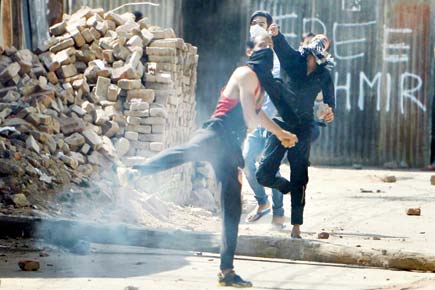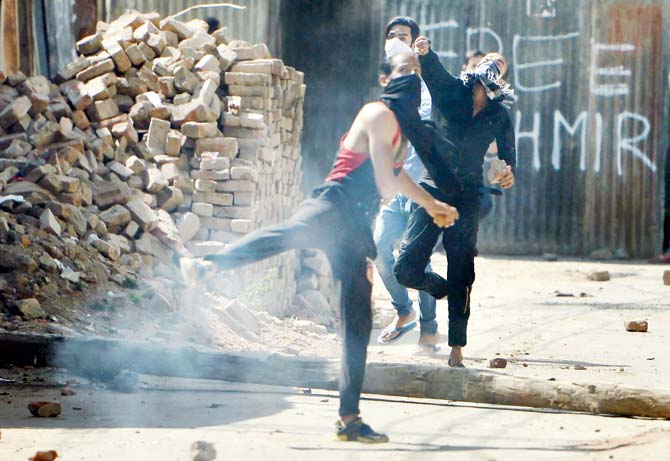We only see red when it comes to Kashmir, and remain blind to the fact that this problem — like all reality — has many shades of grey


Kashmiri protestors pelt bricks and rocks as clashes with the security forces continued this weekend. Pic/AFP
 Every extended family has a cousin who is the black sheep. Cantankerous aunts and their spineless husbands shake their heads in disapproval at this failure, the fellow who brought shame to the memory of his grandfather, a great man. The whispers intensify and become convoluted with unverified detail. In family politics, there are no shades of grey.
Every extended family has a cousin who is the black sheep. Cantankerous aunts and their spineless husbands shake their heads in disapproval at this failure, the fellow who brought shame to the memory of his grandfather, a great man. The whispers intensify and become convoluted with unverified detail. In family politics, there are no shades of grey.
ADVERTISEMENT
If that cousin is around your age, you might pay momentary heed to the tattle, but the minute you lay eyes on him you experience a rush of nostalgia. You’ve known him all your life and you know every humiliation he’s suffered, every setback that crushed his spirit, and every love that went unrequited. All that information means one thing: his situation is complicated. Your opinion is nuanced, unlike that of your bilious auntyjis. And when possible, you try and help him help himself.
This is the truth about truth. There is no absolute reality; no scope for objectivism. Events, opinions, crises — none of these are black and white, no matter what the media or political leadership tell you. How do you tell if politicians or TV channels lie? Simple.
Take the national strike of 15 crore workers ten days back. One of the world’s largest ever strikes received anaemic coverage in most national dailies (with notable exceptions). Nobody abused any journalist for this lapse and it was not because readers/viewers are indifferent. The recent TV interview of Prime Minister Narendra Modi was apparently so widely watched that the news channel proudly announced it had surpassed even the invincible Arnab-channel in ratings on the day that the interview was broadcast over and over. The people want to watch Modi even if he drools twaddle.
The other way you can spot the wall of lies is if a serious crisis just doesn’t seem to end. Kashmir, for instance, is in its third month of curfew; 77 have died and over 10,000 injured. It apparently moves no one anymore. Each time it seems that the crisis might turn a corner, we encounter another corner to turn, like some endless labyrinthine nightmare. Again, our neanderthal political leadership and equally unthinking media — as a whole, with notable exceptions — have covered the crisis in an increasingly sordid manner. The best you can say about the readers/viewers response is that it is indifferent. At worst, it is bloodthirsty, supportive of a no-grey-shades agenda that can have no happy outcome.
This column has often enough railed at the over-exuberant citizens who find any excuse to abuse the media not because they don’t get enough information for informed opinions, but because they get too much information that makes them waver in their support of the government’s agenda. Hence the PM’s preference for unctuous interviewers. The column has also defended media shortcomings as not the result of individual journalist bias but on corporate news management. But, lately, I feel dismay while watching journalists — both collective and individual — and the way in which they report on Kashmir.
The government lies on a regular basis about events in the Valley —there was even a shameless story, without by-line, that said the government was trying to prevent a Wahabbi theocracy from taking over Kashmir. It lies about the kinds of perks it gives separatists (and then backtracks on this lie). It lies about boys taking instructions from Pakistan to throw stones at the authorities. It lies about the historical causes for the unrest.
Shamefully, fewer and fewer journalists call out the government on its lies, and those that do, feel the need to temper their reporting or opinion with concessions to burnish their pro-nation credentials; one example is every journalist’s criticism of separatists, always an easy target, whether or not the story warrants it. More shamefully, the bulk of journalists act as government stenographers. Most shamefully, anchors — and I’m not talking Arnab here — froth at the mouth and declare that separatists = terrorists. Such journalists sound very much like those cantankerous aunts mentioned earlier. No nuance, just someone to dump on.
One government or another will eventually have to settle with Kashmiris, and that process will begin not with Mehbooba Mufti or with Omar Abdullah, but with the very black-sheep separatists that everyone is presently against. In the meantime, the media would do well to play its traditional role and educate the public about the nuances of the problem, instead of trying to steamroll a nationalist agenda. That only requires a pamphlet from the party office. There will come a day when Modi is no longer PM but Kashmir is still a problem for India. That day, people won’t be wrong in blaming the media when they wake up and find that reality isn’t all black and white after all, but with many shades of grey.
Senior journalist Aditya Sinha is a contributor to the recently published anthology House Spirit: Drinking in India. He tweets @autumnshade. Send your feedback to mailbag@mid-day.com
 Subscribe today by clicking the link and stay updated with the latest news!" Click here!
Subscribe today by clicking the link and stay updated with the latest news!" Click here!







